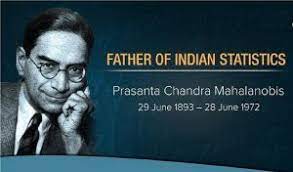02 Jul 2022 National statistics day

- India celebrates National Statistics Day on 29 June every year in honor of the work and contributions of late Professor and Scientist Prasanta Chandra Mahalanobis in the field of statistics and economic planning.
- The Ministry of Statistics and Program Implementation (MoSPI) also recognizes outstanding contributions to the official statistical system by high quality research in the field of applied and theoretical statistics through awards established for this purpose.
Highlights of the Day:
Purpose:
- To popularize the use of statistics in daily life and to sensitize the public on how statistics helps in shaping and formulating policies.
- To raise public awareness about the role of statistics in socio-economic planning, especially among the younger generation.
- Theme for the year 2022: ‘Statistics for Sustainable Development’.
- Statistics Day is celebrated every year with a theme of current national importance.
Prashant Chandra Mahalanobis
- Prasanta Chandra Mahalanobis was a world renowned Indian statistician who founded the Indian Statistical Institute (ISI) in the year 1932.
- He was a trained physicist, at the behest of his teacher WH Macaulay, he read the book ‘Biometrica’. It was only after reading this book that his inclination towards statistics started. Impressed by this book, he bought a complete set of editions of the magazine.
- He soon discovered that statistics could be used in various fields, including meteorology and anthropology, and this proved to be a turning point in his scientific career.
- Mahalanobis made many contributions to statistics, including the ‘Mahalanobis distance’, which is a statistical measure. In addition, he was a pioneer in the field of anthropometry or the study of human measurements in India and assisted in the design of large-scale sample surveys and sampling methods.
- He also created the Feldman-Mahalanobis model, a neo-Marxist model of economic development used in India’s Second Five Year Plan, which promoted rapid industrialization in the country.
- Mahalanobis also served in the first Planning Commission of India. He also received many awards including Padma Vibhushan.
Relationship with Rabindranath Tagore:
- They met for the first time in 1910 at Shantiniketan.
- Rabindranath Tagore, a close aide of Mahalanobis, wrote in the second volume of the Samkhya, “These are dance steps of numbers in the field of time and space, weaving the illusion of presence, a constant flow of change that is and is never.”
- Mahalanobis wrote a series of essays called ‘Ravindra Parichay’ (‘Introduction to Rabindra’) for the prestigious Bengali magazine Probashi.
- PC Mahalanobis also helped Rabindranath Tagore in the establishment of Visva Bharati.
Chronology:
- 1930: For the first time, the ‘Mahalnobis distance’ was proposed, which is a measure for comparison between two data sets.
- The formula is used to find the distance between a point and a distribution based on measurements in multiple dimensions. It is widely used in the field of cluster analysis and classification.
- 1932: Establishment of ISI in Kolkata, which was declared an Institute of National Importance in the year 1959.
- 1933: Beginning of ‘Samkhya: The Indian Journal of Statistics’.
- 1950: Establishment of National Sample Survey and establishment of Central Statistical Organization (CSO) to coordinate statistical activities.
- 1955: Became a member of the Planning Commission and remained in that post till 1967.
- He was instrumental in the preparation of India’s Second Five Year Plan (1956–1961), which laid the roadmap for industrialization and development in India.
- 1968: Awarded Padma Vibhushan.
- He was also honored with many awards by international organizations.


No Comments